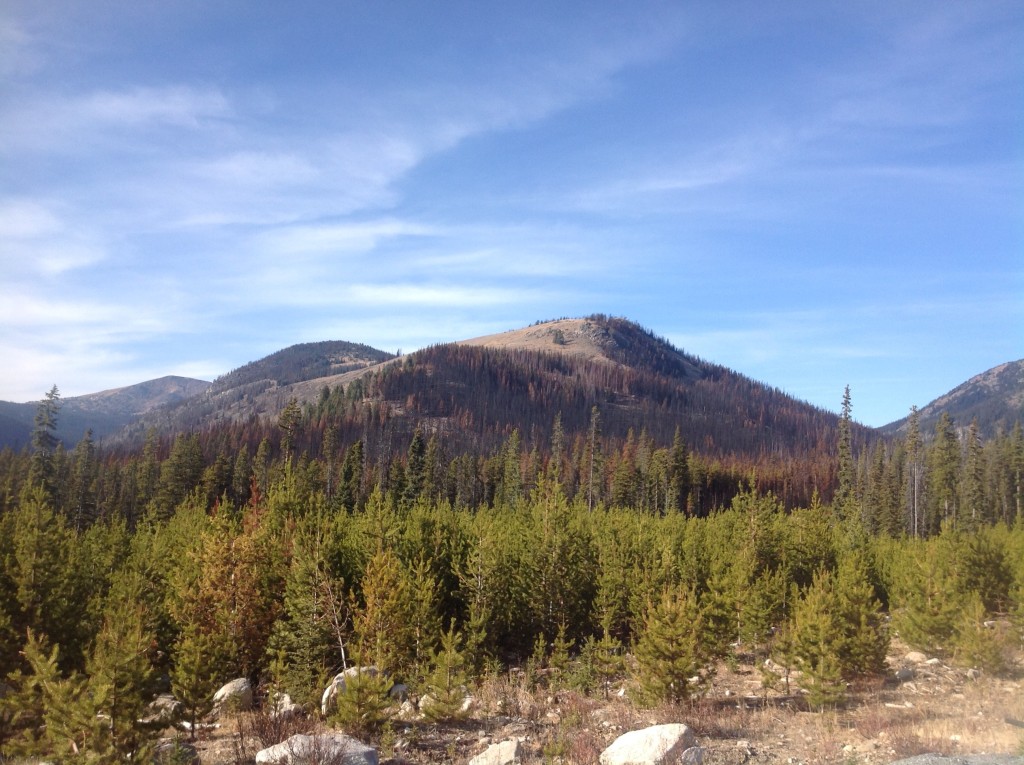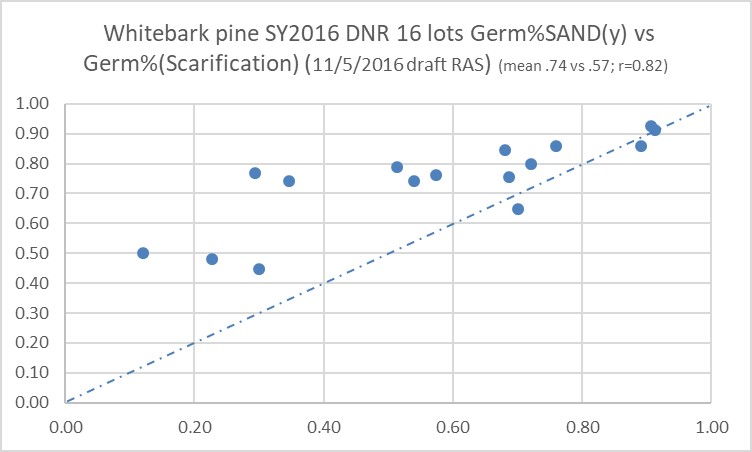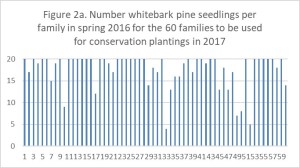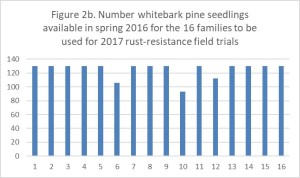2016 In Situ Genetic Conservation, Field Verification of Blister Rust Resistance, and Development of Orchards/Clone Banks/Seed Production Areas for Washington Seed Sources of Whitebark Pine – Field Trials in Washington
Whitebark pine 2015 Good Enough Peak planting site is located on the right side of the bald mountain (center photo).
General Project Information
Project Title:
In Situ Genetic Conservation, Field Verification of Blister Rust Resistance, and Development of Orchards/Clone Banks/Seed Production Areas for Washington Seed Sources of Whitebark Pine – Field Trials in Washington
Project Dates: 2016
Year project implementation started: 2015
How many more years is this project expected to continue, if any? 10++
Project Contact: (Please provide complete information for primary contact(s), e.g., name, position, phone number, email, agency name, unit/sub-unit)
Richard Sniezko, USFS, Dorena Genetic Resource Center (Dorena GRC), 34963 Shoreview Drive, Cottage Grove, OR 97424; 541-767-5716; rsniezko@fs.fed.us
Location (Land management agency or ownership and name of geographic area(s) where project was implemented. This information should be specific enough to identify a general project location on a map but not specific enough to compromise the project.)
Washington (Loomis State Forest, Okanogan County, and Ahtanum State Forest, Yakima County) & Dorena Genetic Resource Center, Umpqua NF, Cottage Grove, OR
Cooperators: (List cooperating agencies and sub-units, other companies/organizations, and individuals as needed.)
Washington State Department of Natural Resources (WA DNR)
Colville Indian Reservation
Project Funding
Funding Sources (amount FHP/amount other incl. in-kind)
Forest Health Protection funding (Dorena GRC) $ 4,000
Other funding (WA DNR) $ 2,500
Total $ 6,500
Note: $14,578 were requested in the proposal ($5,040 to DGRC; $9,538 to WA DNR), but only $6,500 were available.
Did Whitebark Restoration funding get used or obligated? (If not, please explain.) Yes
Project Details
Scope and/or Size of Project or Treated Area: (Include a short description of the project or treatment area if helpful in understanding the scope of the project.)
Up to 9 acres or 2,520 seedlings (and 3 planting sites) – also nursery culture of seedlings at DGRC.
Number of Acres or Other Units Treated, Monitored, or Surveyed:
Specific location of project or treated area(s): (If desired, add more specific project location information here, e.g., UTMs, Lat-long, specific landmark. Otherwise, indicate if more information is available by request.)
Objective(s) (from original request):
1) Grow seedlings to establish three field trials to confirm blister rust resistance from previous seedling trials as well as test durability of rust resistance of whitebark pine families that performed well in screening; monitor growth and adaptability;
(2) Finalize establishment of one additional rust resistant whitebark pine field trial that was planted in fall 2015;
3) Establish in situ genetic conservation plantings that include seedlings from most of the high resistance rated parent trees tested to date from various seed zones in Washington; set up field plantings in manner to potentially become a seed orchard or seed production area;
4) Test two different stratification protocols, one which has shown promise to significantly decrease labor required to germinate whitebark pine (current Dorena GRC protocol versus new protocol that early work shows has high promise (Robb 2014)).
Planting: (Please answer the following questions if the project includes plantings or cone collections.)
Number of seedlings planted (List by location if applicable): None
Was the seed source screened for resistance? (If other, explain.) Yes
Were Plus trees used? Yes
Results/Outcome:
Dorena GRC Activities: Seedlot germination went well. Most seedlots appear to have sufficient seedlings (pending continued survival in the greenhouse) for the plantings scheduled for fall 2017. A summary of the germination trial shows that a new technique is available to use for stratification/germination of whitebark pine.
Break-through event: The new germination technique, using sand media, and not requiring mechanical nicking of the seed, clearly outperformed the standard stratification protocol, and notably for those seedlots with lower germination under the standard Dorena GRC protocol (Fig. 1). Additional whitebark sowings in 2016 at DGRC also generally showed similar results (there were some exceptions that need to be examined further). This ‘new’ protocol has the potential to greatly simply the stratification/germination procedure for whitebark pine (including no mechanical nicking of the seed) while achieving even higher germination percentages. Some similar results were reported recently from a smaller DGRC test (Lindsay 2014, Riley et al. 2016). This technique or variations of it should be considered by all those sowing whitebark pine. We gratefully acknowledge the prior work in Canada that led to this more extensive look at the new technique. This technique offers promise in enhancing the long-term ex situ genetic conservation storage of whitebark pine seeds (Sniezko et al. 2017).
Figure 1. Whitebark pine germination of 16 seedlots using the standard Dorena GRC stratification protocol (involving scarification of seed, etc.), and a new technique using sand (based on earlier work by Lindsay Robb (2014)). Note the substantial improvement in germination of the seedlots that showed low germination% with the standard Dorena GRC protocol (which included ‘nicking’ the seed).
WA DNR Activities: Survival of the WBP seedlings planted in 2015 is high and is estimated to be above 90% via visual observation. We do not have much experience working in high elevation sites and miscalculated our site survey window by a few weeks due to the early onset of snow and cold temperatures in fall 2016. Survey work scheduled for 2016 will be completed in 2017. Three sites were identified and confirmed by cooperators for the 2017 plantings. Two sites will be located on WA DNR lands (Ahtanum State Forest, Yakima County, WA and Loomis State Forest, Okanogan County, WA) and one site on the Colville Indian Reservation (Ferry County, WA).
Project Status (Is the project complete? If not, what remains to be accomplished and when?
This funding was intended to cover the first-year phase and that part went as expected.
Dorena GRC Activities: Seedlings have been sown and are growing in the greenhouses at Dorena GRC (as planned) for planting in fall 2017 in WA. Three thousand and fifty-two (3,052) seedlings (from 75 families and 1 bulked seedlot) were transplanted into tubes in spring 2016 (93 to 130 seedlings for the 16 families scheduled for large trials (Fig. 2b), and 4 to 20 seedlings for the remaining 60 families (Fig. 2a)). A fall inventory is scheduled for December 2016. The germination trial (test of standard technique and new technique) was completed.
WA DNR Activities: (a) The 2015 WBP planting follow-up occurred late in the season with unexpected weather conditions, thus, monumenting of the site is incomplete. This will be completed in summer 2017. Seedling survival was examined and was greater than 90% in fall 2016. (b) Three sites were identified and confirmed by cooperators (WA DNR and Colville Indian Reservation) for 2017 plantings (seedlings are being grown at Dorena GRC in 2016 and 2017).
(click on figure to view full size image)
Will outcome meet objectives? Yes
Project Follow-Up
Are there plans for monitoring or follow-up? (If not, please explain.)
Yes. We expect to establish a total of four WBP field trial sites by spring 2018. Survival surveys, monitoring for blister rust infections, and site maintenance will be conducted annually for five years after planting. Rust surveys and site maintenance will then decrease in intensity, likely occurring every 3 – 5 years. The new stratification/germination protocol will be used in 2017 at DGRC.
Changes Needed or Problems Encountered:
Dorena GRC: None
WA DNR: The 2015 planted WBP site evaluation and monumentation was not completed this year due to personnel and weather issues. We were unable to visit the site until early October and at that time the soil was frozen and the site partially covered in snow and ice. We plan to visit the site in early to mid-summer 2017 to ensure site establishment work gets completed before planting three new sites.
Whitebark pine 2015 Good Enough Peak planting site with whitebark pine seedling in foreground.
References
Riley, L. E., R. E. Watson, and L. A. Winn. 2016. Whitebark pine germination: Is it really that difficult? Tree Planters’ Notes 59 (2): http://www.rngr.net/publications/tpn. (Last accessed 3/21/2017).
Robb, L. 2014. Whitebark pine (Pinus albicaulis Engelm.) germination method. Poster session presented at: 15 years of whitebark pine restoration. Annual Science & Management Workshop of the Whitebark Pine Ecosystem Foundation, 2014 19-20 Sept, Coeur d’Alene, Idaho.
Sniezko, R. A., A. Kegley, and D. P. Savin. 2017. Ex situ genetic conservation potential of seeds of two high elevation white pines. New Forests (2017), doi:10.1007/s11056-017-9579-3




